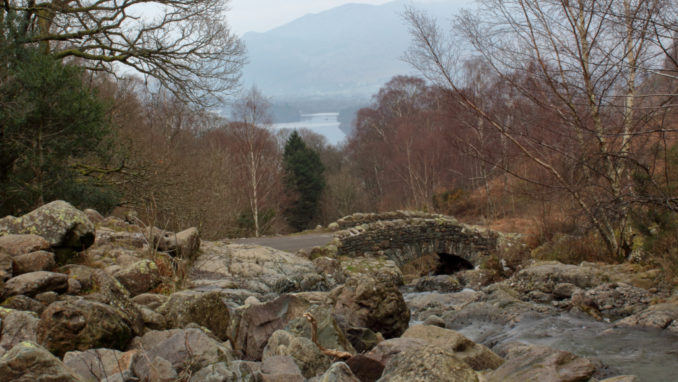
© Colin Cross, Going Postal 2020
It seems an age now since I wrote about the 40 things we were going to do to celebrate our 40th wedding anniversary. To give you some idea, in 8 weeks we’ll have been married for 43 years and the list is still 10 short of completion. We will get there though. On Monday, the occasion of Mrs C’s birthday, we decided to take a walk from Rosthwaite to Galleny Force (known locally as the Fairy Glen) returning via Stonethwaite, a round trip of around 5 miles of mildly undulating paths, a couple of bridges and an astonishing number of gates. Rosthwaite sits in the Borrowdale valley and has the river Derwent flowing through it. It’s a place that many believe to be the most stunning valley in the Lakes. I’m not too certain, I like Rannerdale and Ennerdale, but I still believe, when you take into account Ullswater, that the Eden Valley takes some beating.
Rosthwaite is around 18 miles from my house and I’m still not up to driving too far, but my daughter joined us and took over that side of the job. Parking wasn’t a problem, there’s room for around 30 cars or so, but it’ll no doubt be busy once we get into the “new normal”. When we arrived it was chucking it down, so we delayed departure until there was a break in the clouds and set off. The major part of the outward leg follows the Cumbria Way, which roughly follows the course of Stonethwaite Beck. It isn’t long into the walk until you find out why Borrowdale is seen as a walkers paradise, the views, even on a dull day, are stunning and, if you aren’t looking to be climbing fells, the tracks are manageable for even a one armed old codger like me.
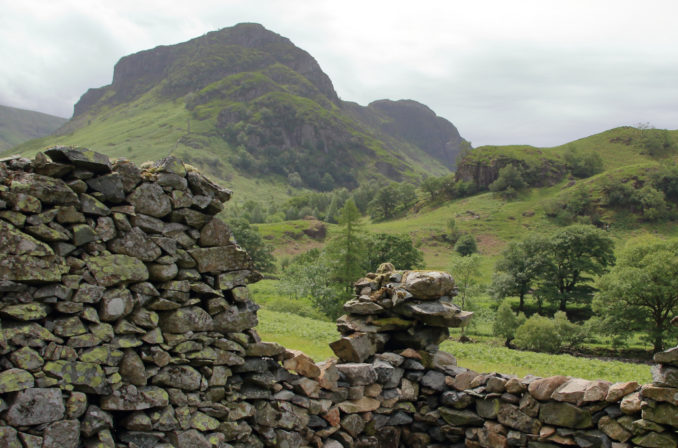
© Colin Cross, Going Postal 2020
Eagle Crag stands proudly in the distance as the walk starts and remains in view for the whole of the outward section, but the length of the path, which passes for much of its distance between fairly high dry stone walls, is framed with fells and crags, perfect for looking at and great for photography. As is usual with a walk in the North Lakes Herdwick sheep are everywhere but they aren’t too fond of humans and tend to move off rather than approach, although this time of year there are lambs about, which the ewes are very protective off. If you have a dog with you, best to keep it on a lead.
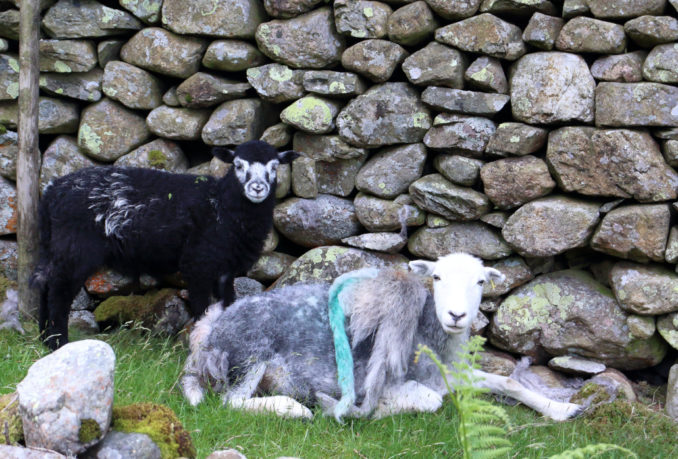
© Colin Cross, Going Postal 2020
After about a mile or so on the Cumbrian Way you could take a short detour and visit Dock Tarn. It’s a bit of a climb, so we left it for a later date, the weather was threatening to close in too, so we kept going, opening and closing gates as we went before arriving at the first of the two bridges that cross Stonethwaite Beck.
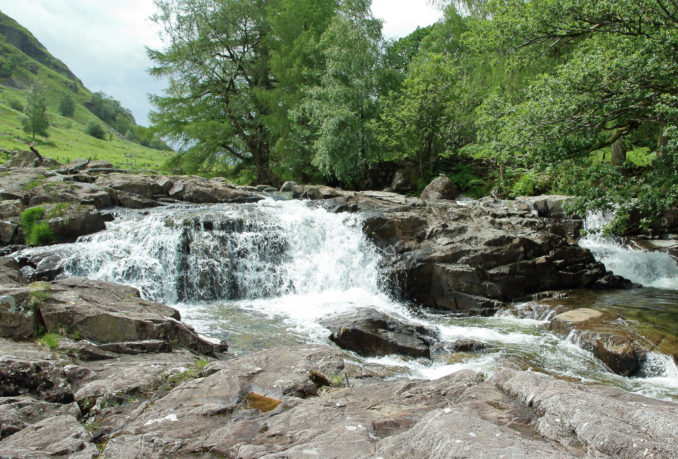
© Colin Cross, Going Postal 2020
Galleny Force consists of a series of waterfalls, rapids and deep-ish pools that become Langstrath Beck, which feeds into the Derwent further down the valley just north of the hamlet of Longthwaite, before the Derwent itself feeds into Derwentwater at the southern end of Keswick. Although the weather was closing in by the time we reached the Falls it stayed fine long enough for us to eat our lunch, take some photographs and drink in the wonders of nature we were surrounded by.

© Colin Cross, Going Postal 2020
We crossed the beck above the last fall and walked back down the path on the other side of the force, taking a short detour to view the calm swimmable pools that are a feature of this “Fairy Glen”. At this point it came on to rain but at least it was coming in from the South West, so with hoods up we set off, opening and closing several gates as we went, and headed across open fields towards the tiny hamlet of Stonethwaite where, in more sensible times, we’d have partaken of a pint at The Langstrath Inn. You may remember a recent article of mine, Postcard From Cumbria; Silloth and Abbeytown which told some of the story of the Cistercian monks and how they had managed and farmed much of what is now modern day Cumbria from the late 12th century through the Middle Ages. Imagine my surprise to find further evidence of their involvement in the area. Abbeytown is close on 40 miles from Stonethwaite, a fair walk leading a pair of oxen and a gaggle of geese, dressed in sandals, cowl and smock.
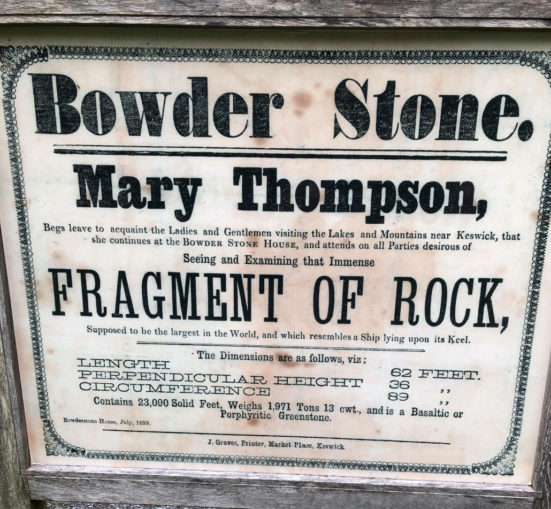
© Colin Cross, Going Postal 2020
We arrived back at Rosthwaite wet and a little bedraggled but we all said it was a walk we’d do again so long as the weather was a little better and we knew the pub would be open. We set off for home but took a couple of detours off the main road to visit a couple of the more famed Lakeland tourist attractions. The Bowder Stone sits in a dip between high crags and the river Derwent. It’s quite an impressive lump of free standing rock and it’s difficult to see how it remains in place as it does, being a bit “top heavy”. I’d visited before but the daughter hadn’t. She was far from impressed, I suppose the Victorians were more easily pleased than today’s 30 something millennial’s.
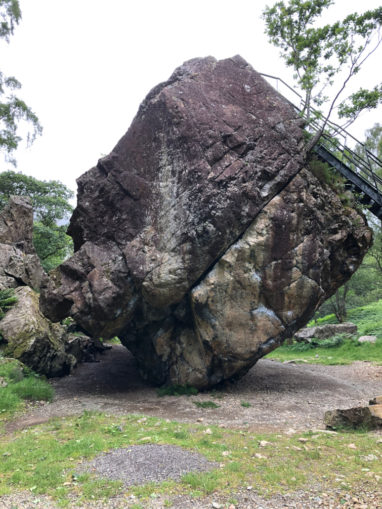
© Colin Cross, Going Postal 2020
Ashness Bridge is a couple of miles closer to Keswick, again just off the main road. It was originally constructed as a “pack horse” bridge and stands 0n what was the single track road between Watendlath and Keswick. It’s said to be the most photographed bridge of its kind in the Lake District. On a clear day and with a precisely placed tripod it’s possible to get a decent photograph of the bridge and Derwentwater in the near distance. The daughter was only slightly more impressed with it than with the Bowder Stone, I think she was of the mind that once you’ve seen one pack horse bridge, you’ve seen them all. A highly recommended easy walk for all, as soon as the “new normal” allows, why not give it a go?
© Colin Cross 2020
The Goodnight Vienna Audio file



